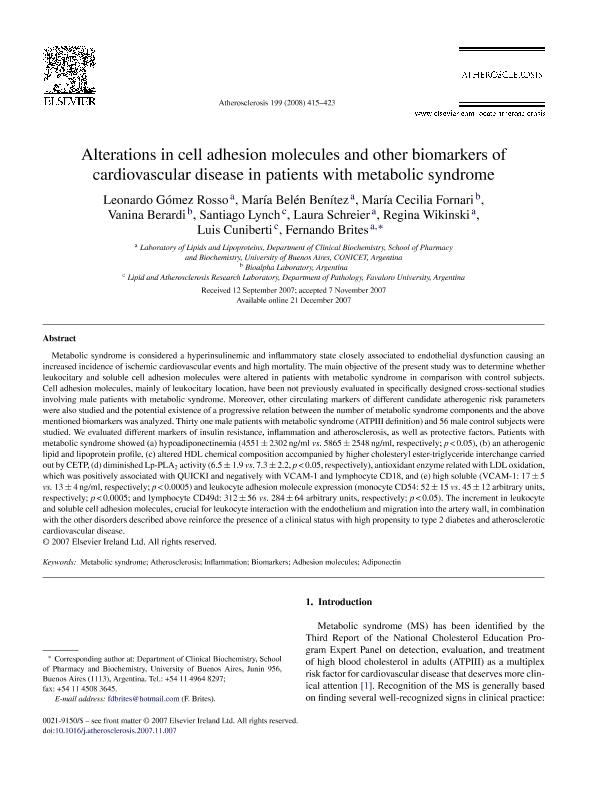Artículo
Alterations in cell adhesion molecules and other biomarkers of cardiovascular disease in patients with metabolic syndrome
Gomez Rosso, Leonardo Adrián ; Benítez, María Belén; Fornari, María Cecilia; Berardi, Vanina; Lynch, Santiago; Schreier, Laura Ester; Wikinski, Regina; Cuniberti, Luis Alberto
; Benítez, María Belén; Fornari, María Cecilia; Berardi, Vanina; Lynch, Santiago; Schreier, Laura Ester; Wikinski, Regina; Cuniberti, Luis Alberto ; Brites, Fernando Daniel
; Brites, Fernando Daniel
 ; Benítez, María Belén; Fornari, María Cecilia; Berardi, Vanina; Lynch, Santiago; Schreier, Laura Ester; Wikinski, Regina; Cuniberti, Luis Alberto
; Benítez, María Belén; Fornari, María Cecilia; Berardi, Vanina; Lynch, Santiago; Schreier, Laura Ester; Wikinski, Regina; Cuniberti, Luis Alberto ; Brites, Fernando Daniel
; Brites, Fernando Daniel
Fecha de publicación:
12/2008
Editorial:
Elsevier Ireland
Revista:
Atherosclerosis
ISSN:
0021-9150
Idioma:
Inglés
Tipo de recurso:
Artículo publicado
Clasificación temática:
Resumen
Metabolic syndrome is considered a hyperinsulinemic and inflammatory state closely associated to endothelial dysfunction causing an increased incidence of ischemic cardiovascular events and high mortality. The main objective of the present study was to determine whether leukocitary and soluble cell adhesion molecules were altered in patients with metabolic syndrome in comparison with control subjects. Cell adhesion molecules, mainly of leukocitary location, have been not previously evaluated in specifically designed cross-sectional studies involving male patients with metabolic syndrome. Moreover, other circulating markers of different candidate atherogenic risk parameters were also studied and the potential existence of a progressive relation between the number of metabolic syndrome components and the above mentioned biomarkers was analyzed. Thirty one male patients with metabolic syndrome (ATPIII definition) and 56 male control subjects were studied. We evaluated different markers of insulin resistance, inflammation and atherosclerosis, as well as protective factors. Patients with metabolic syndrome showed (a) hypoadiponectinemia (4551 ± 2302 ng/ml vs. 5865 ± 2548 ng/ml, respectively; p < 0.05), (b) an atherogenic lipid and lipoprotein profile, (c) altered HDL chemical composition accompanied by higher cholesteryl ester-triglyceride interchange carried out by CETP, (d) diminished Lp-PLA2 activity (6.5 ± 1.9 vs. 7.3 ± 2.2, p < 0.05, respectively), antioxidant enzyme related with LDL oxidation, which was positively associated with QUICKI and negatively with VCAM-1 and lymphocyte CD18, and (e) high soluble (VCAM-1: 17 ± 5 vs. 13 ± 4 ng/ml, respectively; p < 0.0005) and leukocyte adhesion molecule expression (monocyte CD54: 52 ± 15 vs. 45 ± 12 arbitrary units, respectively; p < 0.0005; and lymphocyte CD49d: 312 ± 56 vs. 284 ± 64 arbitrary units, respectively; p < 0.05). The increment in leukocyte and soluble cell adhesion molecules, crucial for leukocyte interaction with the endothelium and migration into the artery wall, in combination with the other disorders described above reinforce the presence of a clinical status with high propensity to type 2 diabetes and atherosclerotic cardiovascular disease.
Archivos asociados
Licencia
Identificadores
Colecciones
Articulos(OCA HOUSSAY)
Articulos de OFICINA DE COORDINACION ADMINISTRATIVA HOUSSAY
Articulos de OFICINA DE COORDINACION ADMINISTRATIVA HOUSSAY
Articulos(SEDE CENTRAL)
Articulos de SEDE CENTRAL
Articulos de SEDE CENTRAL
Citación
Gomez Rosso, Leonardo Adrián; Benítez, María Belén; Fornari, María Cecilia; Berardi, Vanina; Lynch, Santiago; et al.; Alterations in cell adhesion molecules and other biomarkers of cardiovascular disease in patients with metabolic syndrome; Elsevier Ireland; Atherosclerosis; 199; 2; 12-2008; 415-423
Compartir
Altmétricas



